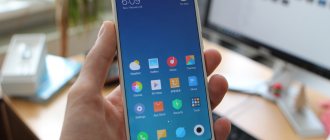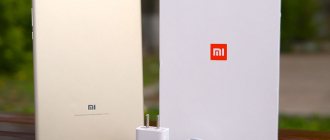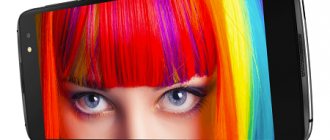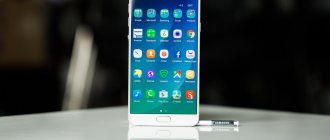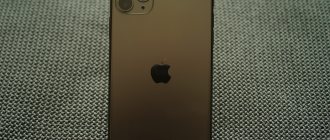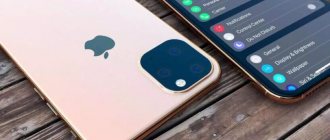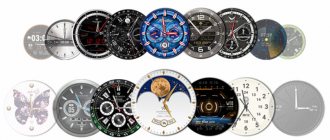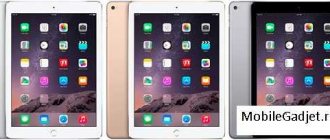iPad 2020 review. The most budget-friendly iPad
The tablet market has been stagnating for a long time.
First of all, this is due to the fact that tablets do not provide us with something unusual, something that a laptop or smartphone cannot provide. In 2010, Steve Jobs said that tablets would take an important place in our lives, but this never happened. I've used quite a few iPads, from the very first one to the iPad Air. And for me, these tablets have always been the best; no Samsung or Asus will ever be equal to the iPad.
The only tablet that can come close to the iPad is the Sony Xperia Z4 Tablet. But let’s not talk about sad things, but let’s move on to the iPad 2020. The Cupertino team presented a device with good, even today, characteristics and a polished design. And all this for an affordable price tag. Let's begin!
Advantages and disadvantages
To summarize, I will note the pros and cons of the new tablet from Apple.
Pros of iPad 2017 :
- quality of materials
- stylish design
- great screen
- sufficient memory
- high performance
- low heat
- excellent autonomy
- good sound quality
- well-thought-out operating system
Cons of iPad 2017 :
- unimportant fingerprint scanner
- bad cameras
- lack of GPS (in Wi-Fi version)
- iOS limitations (inconvenient file sharing)
- no support for proprietary keyboard and stylus
iPad 2020 Specifications
- Display: IPS, 9.7″, 2048×1536 (264 ppi), capacitive, multi-touch
- Chipset: Apple A9 1.85 GHz 2 64-bit cores, PowerVR GT7600, M9 motion coprocessor
- RAM: 2 GB
- Built-in memory: 32 GB
- Main camera: rear 8 MP, video recording 1080p
- Front camera: 1.2 MP, 720p video via FaceTime
- Communication:UMTS/HSPA/HSPA+/DC-HSDPA (850, 900, 1700/2100, 1900, 2100 MHz); GSM/EDGE (850, 900, 1800, 1900 MHz), CDMA EV-DO Rev. A and Rev. B (800, 1900 MHz), LTE (bands 1, 2, 3, 4, 5, 7, 8, 12, 13, 17, 18, 19, 20, 25, 26, 27, 28, 29, 30, 38 , 39, 40, 41)
- Connectors and sensors: 3.5mm, Lightning, 1st generation fingerprint sensor.
- Battery: 32.9 Wh / 9000 mAh
- Case material: aluminum, glass
- Operating system: iOS 11.2.2
- Dimensions: 240×170×7.5 mm
- Protection: no
Performance
The 16nm Apple A9 processor operates at a maximum frequency of 1.85 GHz. The hardware platform also includes a PowerVR GT7600 GPU and 2 gigabytes of RAM.
A similar chipset configuration has already been used in the iPhone 6s and iPhone SE. Apple has never used such a processor on the tablet market before. In terms of power, it lags slightly behind the flagship Pro models, but shows satisfactory results in tests and in practice.
3DMark was used to test the graphics accelerator. As can be seen from the results, the iPad lags behind the Pro version, but is significantly ahead of the second generation tablets from Apple.
Based on the data obtained, we can say that the power reserve of the device is enough to perform most everyday tasks. It will cope perfectly with almost all games, modern 3D graphics and processing large amounts of data. The device OS is represented by the tenth version of iOS.
Heavy use causes slight heating on the right side of the iPad. It is there under the case that the processor is located, which during active operation adds several degrees of temperature. However, heating is not critical; after several hours of operation, the metal surface of the case reaches 38 degrees Celsius, which is not much. Similar indicators are observed in Air 2 and Pro.
For those who like watching movies on a tablet, we still recommend choosing the version with 128 GB of internal memory. In all other cases, data storage can be entrusted to iCloud.
Design and ergonomics
Over the years, the Apple team has worked to create designs for the iPad. The tablet is made in a simple style. There is nothing superfluous in the iPad 2020, everything is symmetrical and even. The body is made of aluminum, with a glass apple cutout.
But if we remember the first Air, then, in fact, it is the same design, only with some cosmetic modifications. Compared to the second Air, the iPad 2020 is several millimeters thicker, but this is not a minus, but rather a plus due to a more capacious battery.
If you look at this iPad without looking back at past generations, you can say that the design was successful. But what I don’t like about modern iPads is that the frames have become narrower and the tablet can no longer be held with one hand without touching its screen. It is also unclear why the orientation lock button was removed.
Among the advantages, I can highlight the materials from which the iPad 2020 is made. After several weeks of use, there are no scratches or paint chips on the lid, bevels and screen. The anodization of the body is high quality.
Ease of use.
There are no questions with ergonomics. iPad 2020 is very light, it will not cause discomfort even if we carry it in one hand. The oleophobic coating is also excellent; prints are erased easily and quickly.
The only thing I can complain about is the very slippery body. If you keep this in mind when purchasing, I advise you to take the original case (SmartCover or another option).
Equipment and design
Apple branded solutions greet the user already at the unpacking stage: a pleasant matte surface of the box, a familiar design, a traditional set and arrangement of components. In addition to the tablet, the kit includes a charging hub, a Lightning cable, an insert with tips and two stickers. No paperclip: Lifehacker's review involves an iPad Wi-Fi that does not support the use of a SIM card.
The body of the new iPad repeats the first iPad Air down to the millimeter. Device dimensions - 240 × 169.5 × 7.5 mm. The weight is the same as the 2013 tablet, and is 469 g and 478 g in the Wi-Fi and Wi-Fi + Cellular versions, respectively. The only external difference from the iPad Air is that the mute button, which was lost during the production of the iPad Air 2, was not returned to the new iPad. Well, the speaker holes are now located in one row, like in the iPad Air 2.
On the left is the iPad Air 2, on the right is the iPad.
Such solutions are not new for Apple: something similar happened last year, when the company presented the iPhone SE - iPhone 5s with improved and more modern “filling”. Such an upgrade of time-tested devices allows you to significantly save on the cost of the final product, which ultimately affects the price for the buyer. Borrowing from previous technological solutions gives users another non-obvious advantage: the new iPad will be compatible with cases for the iPad Air, iPad Air 2 or iPad Pro 9.7.
For those who have not interacted with Apple tablets before (what if!): on the upper edge of the aluminum case there is a headphone jack (3.5 mm) and a lock / power button, in the upper part of the right edge there are volume keys, in the center of the bottom edges - Lightning input for the charger, surrounded on both sides by speaker holes. At the bottom is the Home button, the only mechanical key on the front of the iPad. All buttons look beautiful and respond pleasantly to pressing.
The new iPad is available in three colors: silver, gold and space gray. The rose gold version is only available in the iPad Pro line.
Screen
The iPad 2020's display is good, but not great. For the average user, the quality of the matrix is enough, but for fans of flagship devices this will not be enough. This is a regular, non-TrueTone screen with a 60Hz refresh rate. It's not as smooth or bright as the iPad Pro 10.5, but it's still good.
It’s clear that Apple wanted to save money, but I can’t blame them for that. They simply couldn't make it better with a $330 price tag.
Otherwise, the screen of the iPad 2020 is excellent, the color reproduction is accurate, and at an angle the screen goes slightly into cool colors. The minimum brightness is enough to comfortably read a book in the dark; in addition, there is NightShift. Maximum brightness is also enough. On the street, in daylight, everything is visible and reading any text does not cause discomfort.
Features and Performance
The main advantage of the iPad over the iPad Air and Air 2 is the 64-bit A9 processor. This is not Apple's most powerful processor: the Pro series tablets have the A9X, and the iPhone 7 has the A10. The amount of RAM is 2 GB.
The Macworld portal tested the processors of 9.7-inch Apple tablets in GeekBench 4. It can be seen that the new iPad is significantly ahead of the iPad Air 2 in single-core mode and is about as fast in multi-core mode. This is explained by the different number of cores: the new iPad has two, the iPad Air 2 has three.
The new iPad's GPU test in the 3DMark Sling Shot Benchmark app showed good results: the A9 and PowerVR GT7600 GPU gave the tablet an advantage over the iPad Air 2, with a performance index of 2,241 points. A similar test of the iPad Air 2 gave a result of 2,014 points. But not everything is so simple: the new tablet has surpassed its predecessor in graphics, but not in physics.
The iPad 2020 is sold with iOS 10.3 pre-installed. The App Store offers over a million apps, and you can be sure that even the heaviest ones will install, run, and function perfectly on your new iPad. Many functions introduced in the latest versions of iOS are also supported: Night Shift, Apple Pay, Touch ID (first generation), multitasking.
At the user level, the performance of the iPad Air 2 and the new iPad is almost identical. Both tablets handle even the most demanding applications from the App Store very well; minor nuances may arise only during video rendering and other specific operations.
The iPad 2020 not only doesn't offer innovations, but also abandons some of them implemented in more expensive tablets.
The new iPad does not support Apple Pencil, does not have a Smart connector for connecting a keyboard, and does not have an additional pair of speakers, like the iPad Pro. Let's be honest, the only pity is the dynamics.
There are two classic modifications available to choose from: Wi-Fi and Wi-Fi + Cellular. In addition, tablets are sold with different amounts of memory: 32 GB and 128 GB. If 128GB isn't enough for you, you'll have to buy an iPad Pro.
In Internet characteristics, everything is traditional: the new iPad uses the same Wi‑Fi 802.11ac standard with MIMO technology, as in the iPad Air 2 and iPad Pro. The maximum throughput declared by the developer is 866 Mbit/s.
Software
Recently, people have become accustomed to criticizing Apple for the speed of the system, bugs and much more. When I bought the iPad, I thought that I would also encounter a bunch of iOS 11 bugs, but fortunately, the picture turned out to be much rosier than it could have been.
At the moment, I have iOS 11.2.1 installed. Overall, iOS 11 is a giant leap for the iPad. This version actually adds a lot of new features for tablets. Now this is not just a reader or a multimedia device, but an almost full-fledged device for work.
Interaction with files has moved to a whole new level. Firstly, the Files application was added, which allows you to properly manage your files on the iPad, however, this application is still far from being at the “Finder” level. Secondly, a drag-and-drop feature has appeared. That is, if you hold down some picture or text in one application, you can drag it into a completely different one, and it is not necessary to use split screen.
The Dock panel appeared, like on serious Macs. You can place any applications here and also recently launched programs are shown here. Multitasking has also changed, now it is in the form of cards, and opposite there is a control center.
Now it's worth talking about the disadvantages. In general, the system works quickly and adequately. But with rare exceptions, animation bugs appear. In general, this problem has been going on since iOS 9 and it’s unclear why Apple can’t bring animations to fruition.
In addition, the developers turned the intuitive Settings application into some kind of mess; after Android, it is especially difficult to understand what is where. In other words, “Settings” needs to be reworked, because now it’s quite difficult to find something without using the search.
During my use, the Music application crashed a couple of times, which I was extremely surprised by. I still can't understand how one of the main applications on a tablet can crash. Other system applications and programs, such as Pages, Keynote and GarageBand, work stably.
PC connection and file sharing
When connected to a computer using a USB cable, the iPad is detected in the system, and a prompt appears on its screen to allow access to media files. After this, photos and videos taken on the iPad become available for downloading in Windows Explorer.
A folder with photos and videos (494 files, 1.66 GB) was copied to the PC hard drive in 2 minutes. 5 sec. According to calculations, the speed is 13.6 MB/s, which doesn’t seem like much, but it feels like everything happens quite quickly.
It is not possible to copy any files from a PC to an iPad in the same way; for this you need to use the proprietary iTunes program. In it you need to log in with your Apple ID and bind your iPad by connecting it to your PC with a cable. After this, you can enable synchronization via Wi-Fi, but for some reason many of my files were not synchronized over the air.
There were no problems with transferring music to the iPad; all you had to do was drag folders with MP3 files into the program window and they were quickly uploaded to the tablet.
Also, everything turned out fine with the books.
With films, everything is not so simple; the MP4 format is mainly supported (well, also M4V and MOV). The rest (AVI, MKV) must either be converted to this format first, or install a third-party player that supports all formats (the best “AVPlayer for iPad”). For example, I installed the free player “VLC for Mobile” (but it does not support all codecs and is sometimes buggy).
After that, in iTunes you need to go to your device (iPad) and in the “Shared Files” section there will be a list of programs (including the player) that have their own storage where you can add files supported by the program (for the player these are various video formats).
In the screenshot above there is also the “Documents” program, which is one of the best free file managers (explorer), you can upload documents in various formats, archives and other types of files to its folder. It will also be needed to download files from the Internet, because in the Safari browser it is problematic to do this without a third-party file manager.
But it’s worth considering that in iOS there is a clear division of files into programs; as in Android, you can’t just throw everything into one folder and then open it using Explorer. Files are displayed in the programs in whose storage they are located, so to open a file you need to open the program to which it is linked.
In smartphones and tablets on Android, everything is much simpler: you connect to the PC with a cable or via Wi-Fi, and then you simply put the files like on a flash drive into folders that are convenient for you. In the iOS system, everything is much more complicated and tedious, but in principle it is well thought out and you can get used to it, you just need to figure it out.
Yes, Bluetooth file sharing is limited to only between Apple devices and only to a certain type (for example, a personally taken photo). Since the American manufacturer sacredly observes the covenants of copyright protection, Bluetooth in their devices is mainly suitable for connecting wireless headsets and keyboards.
Camera
This point is actually the least I want to touch upon, since both iPad 2020 cameras do not shine with photo capabilities. But I immediately want to know - who would take pictures of anything on a tablet?
The resolution of the main camera module is 8 megapixels. The maximum video recording resolution is 1080p at 30 fps, slow-mo shooting at 720p at 120 fps. The pictures come out quite good, the quality is enough for shooting documents or for a spontaneous photo on the street in good weather.
The 1.2 megapixel front camera leaves much to be desired, although it is definitely enough for FaceTime conversations. There is also Retina Flash - both cameras can shoot LivePhotos, but who cares - the function is still useless.
Photo and video
The quality of the photos is not as great as in the Pro versions, but still at a fairly good level. The main camera or iSight is an 8 megapixel sensor. The tablet does not have a flash. But there is slow motion shooting at a speed of 120 FPS. Also, a big difference from more expensive models is that our version cannot shoot video in 4K resolution.
The original photos can be viewed here.
Main camera
- resolution 8 MP
- aperture f/2.4
Overall, I'm very pleased with the photo quality from the main camera.
The sensor almost instantly determines how much light needs to be left in the frame. I would also like to note the decent detail of the images for a tablet and the low amount of noise in artificial lighting.
Front-camera
- resolution 1.2 MP
- aperture f/2.2
But here you can already criticize mercilessly: firstly, what are 1.2 megapixels in 2020?
I didn’t even have to reduce the resolution to upload photos to the review, because it’s already lower than anything. The resolution of photos on the front camera is 960 x 1280. Nevertheless, the detail of the face is at a pleasant level, but the frames are only suitable for viewing in front of the screens of mobile devices and tablets.
Secondly, as soon as a dark area appears in the frame, it will definitely be full of noise. This can be seen at the top in the examples above.
Video shooting
This is also a strong point of the new iPad 2020. Although there is no 4K recording or slow motion at 240 FPS, the 1080p videos turn out excellent, very smooth and without twitching. The best video stabilization I've seen. There is no such “stub” even in the Huawei P10, although the latter should be better.
Performance and runtime
Like the iPhone 6s, the iPad 2020 has an old Apple A9 chip with an M9 co-processor. But the fact that there is a processor from the “last century” does not mean that the power is not enough for some applications. On the contrary, there is enough power everywhere. There's not even throttling. I was pleasantly surprised that applications lingered in RAM for a long time.
I had no problems with frame drops in games; Deus Ex: The fall and Civilization 6 ran quite smoothly. I also had no problems in AR applications, everything works tolerably, as I have said many times.
And in some tanks or in GRID there will be problems with the frame rate, but let’s give the iPad 2020 its due, it doesn’t try to show off its incredible power. If you need performance, go ahead with the Pro line.
Autonomy.
In terms of autonomy, the iPad 2020 is doing very well. There is an almost 9000 mAh battery installed here, a full charge of which will last for 3-4 days of moderate use or 1.5-2 days of intensive use. But the charge of the model with Celluar most likely lasts for less time.
Sound quality
The sound of the external speakers of the iPad 2020 is noticeably different from most Android tablets and smartphones. It is quite loud and bassy, the tablet even shakes a little from it and you can feel the air wave at the output of the speakers.
Overall the sound is pleasant, but all frequencies sound lower than they should. Highs are closer to mids, mids with a characteristic silky bass, and basses are somewhat hypertrophied. At the same time, the compositions do not slide into mush, but sound with more or less normal detail.
An additional advantage is that even if you block one speaker with your hand (while playing or watching a video), the sound will not suffer much, since the second speaker will remain open. By the way, the sound in games and movies is great, I liked it.
In standard earbuds from an HTC smartphone, which have generally good sound but a complete lack of bass, music sounds much better than on Android tablets and smartphones. The iPad pulls the sound down and everything falls into place - the highs don’t ring, the mids sound saturated and even soft transparent bass appears.
I also tested the sound in the HyperX Cloud Core headphones, which sound great from a high-quality PC audio codec and on any smartphones, giving bright, bassy sound with excellent detail across the entire frequency range. However, on the iPad the sound turned out to be greatly exaggerated towards low frequencies and it was unpleasant to listen to music.
In general, the sound both in the speakers and in the headphones is embellished and all frequencies are lowered, which in principle sounds good and should be liked by many. But to get a pleasant sound, it is better to use headphones with a natural, non-bass sound. As for the volume reserve, it is huge, at 100% you can simply go deaf. A level of 70-80% is already quite loud, I wouldn’t set it any higher, but the fact that there is a reserve is good.
Communication and sound
It’s difficult to say about the antenna connection, since I have a model without a SIM card, but as far as I know, the modification with an antenna catches the network perfectly. The quality of the built-in microphones is very pleasing; the interlocutor will hear you clearly.
iPad 2020 received exactly the same speakers as Air 1/2. The volume reserve is enough to watch some blockbuster; it feels like about 1/2 the sound of the MacBook Air 2020.
The sound through the headphones is the same as on all iPhones, that is, not bad. Using the equalizer, you can adjust the sound quality in different ways from already prepared settings.
Packaging and equipment
The iPad 2020 is packaged in a small white box with virtually no information on it.
On the back there is a sticker from which we recognize a more precise marking - MP2F2LL4/2 iPad Wi-Fi 32GB Space Gray (Model A1822).
We received the tablet with an American plug, besides which there was only a USB-Lightning cable and several pieces of paper with stickers.
I had to separately buy an adapter for a Euro plug.
The charger itself has a current of 2.4 A.
Review of Apple iPad Air (5th generation)
The editors would like to thank the ITMag Premium Reseller online store for providing the iPad Air for review.
A girl of about nine years old was sitting at the table opposite. She looked in my direction without blinking. There was a mixture of admiring helplessness and racial hatred in her gaze. No, she's unlikely to remember my face. But my hands will probably live in her memory for a long time (5 months). Because in them I squeezed what her soul yearns for - the newest, coolest iPad with the airy name Air. While I was wondering why such a little girl might need the latest and most productive Apple device (besides the obvious reason to show off to her classmates), she, continuing to stare at it, in a broken whisper, told her friend, indifferently chewing a hamburger, something about a “64-bit processor.” , “powerful co-processor”, “thinner frame, like a mini”, “less weight” and “retina again”. Taken aback, I decided to take my thoughts back. The young man is well aware of what he wants! And this is worthy of respect. I think that among potential owners of new iPads, such knowledgeable users are unlikely to reach a few percent. Truth: if we give a very brief description of the fifth generation of full-size Apple tablets, the words of this girl are quite enough. Little girls aren’t the same anymore, I thought. And that's great! Apple tablets are also not the same anymore. And at first glance this is also wonderful. But you need to take a closer look.
BREAK
Video review
How it was
For those who do not follow the development of Apple technology as closely as the girl from the cafe mentioned above, or who missed this chapter in the history of gadget development, let me remind you of the main milestones of “iPedo construction.” The birth of a new device, the iPad, took place in 2010. With it began the era of Internet tablets. Contrary to the predictions of numerous skeptics, this breed has spread quite quickly, partly replacing portable laptops and netbooks. The first iPad was heavy (680 and 730 grams depending on the absence/presence of a 3G module), but they didn’t know about it yet. Because there was nothing special to compare with. This machine immediately received an excellent 9.7-inch screen for those times (and, perhaps, not every tablet can boast of this today) with an IPS matrix, 3:4 aspect ratio and a resolution of 1024x768 pixels.
The following year, 2011, the world was presented with one of the most successful incarnations of Apple tablets - iPad 2. The “second” was much lighter and faster, its design also underwent certain changes. And, by the way, we saw this design not only in the second, but in the third and fourth models without any special changes. This model is still in production today, now considered a budget version of the iPad, while the next two updates have already been discontinued. It weighed 613 grams with 3G and 12 grams less without it. It wasn’t that they criticized him for the screen, which also had a resolution of 1024x768 pixels, but they wanted more. What we wanted, we got: the long-awaited Retina (2048x1536 pixels) really makes the image incredibly smooth and somehow... airy. Only now the weight of the third iPad, which at one time was called “The New iPad,” has grown to 652/662 grams. There was a more powerful processor, double the amount of RAM, and a capacious battery... It got pretty hot, this new iPad, and it didn’t take long for the next update to arrive. Next was the iPad 4, featuring a more energy-efficient processor, and then... There was also the iPad Mini, which literally blew up the market: the same as the iPad 2, but in a light and compact eight-inch body! With a beautiful thin frame. With stereo speakers... Well, except that Retina is not enough. Naturally, the second iPad Mini will correct the situation, but for now - for now we have an iPad Air with a design like the iPad Mini...
iPad Air specifications
| Apple iPad Air | |
| operating system | Apple iOS 7 |
| Display | 9.7 inches, IPS, Retina (2048×1536 pixels), 16 million colors, 10 simultaneous touches |
| CPU | Apple A7, two Apple Cyclon cores (ARMv8 A32/A64), clock frequency 1.4 GHz; M7 coprocessor, one ARM Cortex-M3 core, PowerVR G6430 video accelerator |
| RAM | 1 GB |
| Flash memory | 16, 32, 64 or 128 GB |
| Camera | 5 MP, autofocus, 1080p video recording; front camera for video calls (1.2 MP) |
| Wireless technologies | Wi-Fi a/b/g/n (2.4/5 GHz), Bluetooth 4.0, 3G (optional) |
| Battery | non-removable, 8827 mAh |
| Navigation | GPS, A-GPS, GLONASS |
| Interfaces | Apple Lightning, 3.5 mm headphone output |
| Dimensions and weight | 240x170x7.5 mm, 478 grams |
Equipment
Traditional white box. From all the information diversity of the world, on it you can see a photo of the device, its name, and also, in small letters on the back, the version of the device (with or without 4G support, the built-in storage capacity is from 16 to 128 GB. We are testing the version with 64 GB ). In equally traditional niches are a charger, a USB-Lightning cable, an envelope with a key for removing or installing a nanoSIM, stickers with apples, and an extremely laconic device for use.
Design and construction
The comparison with the iPad Mini, which has been hackneyed since the announcements, is reasonable. The iPad Air indeed takes its design cues from its smaller brother: the same proportions, the same thin bezel, which is especially thin along the long edges of the device. The corners are less rounded, but the curve from the back to the screen is sharper. There is also a shiny edging around the perimeter of the device.
The device creates the most ethereal impression: those who are familiar with at least one full-size iPad of any generation will understand what I mean. If previously there was only a slight decrease in the weight of the device (and sometimes, on the contrary, an increase), now the tablet has become lighter by as much as 183 grams. As a result, we get 478 grams. And this is very small for a tablet with a 9.7-inch screen diagonal!
Together with iPad 2
Together with iPad 2
Thin, 7.5 millimeters, iPad Air does not tire your hands when using it for a long time. Although, of course, some will prefer the more compact second-generation iPad Mini with similar hardware, a Retina display and a weight of 341 (331) grams. The difference in weight in the case of the two newest iPads is quite reasonable, it is justified by the size of the screen.
The device fits well in your hands and can slide, but not too much. The quality of materials again pleases and leaves all competitors, even the most famous and serious ones, far behind.
In the case of the 4G version, a thin but durable sheet of anodized aluminum is diluted with a plastic strip, very thin glass is used - in many ways, it was the materials that contributed to the reduction in weight and dimensions.
At the same time, the assembly is again at its best: no creaks, gaps or deflections. All buttons and connectors fit perfectly. When you press the buttons, you feel a clear click with your fingers. The only thing that shows a decrease in the rigidity of the structure is small streaks on the screen when you press hard on the matrix.
The color of the device is white on the screen side (frame) and silver on the back. Now this color is called Silver. Black, to match the iPhone 5s, became Space Gray or “Wet Asphalt” in our opinion. Noble. I haven't heard of the gold version. The case, as usual, is non-separable. The arrangement of all elements coincides with - whoever you think - of course with the iPad Mini. Top left is the audio jack, right is the power button. At the top of the right side there is a Mute toggle switch for muting the sound, as well as separate buttons for adjusting it, replacing the traditional rocker.
Well, the best part is that, like the Mini, the device is equipped with two speakers. They are located on the bottom edge, separated only by the Apple Lightning connector.
The Home button on the iPad Air is traditional. Alas, there is no such convenient fingerprint scanner as the iPhone 5s.
Display
The main characteristics suggest that the Air's screen has changed little compared to the previous two full-size iPad models. IPS with a diagonal of 9.7 inches, resolution 2048×1536 pixels. And my favorite (at least by me) aspect ratio is 4:3. However, there are certain changes.
For a user unprepared for such high quality, the screen makes an indelible impression: the dots are not visible at all, the icons seem to float above the background - such a 3D effect is observed. Especially in combination with a thin frame. By the way, the protection against false alarms at the edges is also excellent. At the same time, the screen sensitivity does not disappoint either. The maximum brightness has increased (360 cd/m2), as has the contrast. The color rendition and color gamut close to sRGB are pleasing. By the way, the maximum brightness is almost always too much; even on a sunny day, 80% was enough for me, and in the dark I reduced this figure to 60%. The only thing that disappoints, even if only a little, is the presence of an air gap between the matrix and the protective glass: there are glares, although the iPad Air is one of the best in this regard. Movies and games look great on it. And this is not because I love Apple, but because objectively it is so. In all my time, I have not met a single tablet with a better screen than this one.
System and performance
Regarding the iOS 7 operating system, I don’t have much to add other than what was already said in the iPhone 5c review. In turn, the hardware is described in detail in the iPhone 5s review. The new iPad uses the same dual-core 64-bit A7 processor, M7 coprocessor, and quad-core PowerVR G6430 graphics. Only the A7, located inside the iPad Air, has each core running at 1.4 gigahertz, while the heart of the smartphone beats at 1 GHz. There is only a gigabyte of RAM, which will cause a contemptuous laugh from fans of flagship Androids. Apple apologists will tell them that iOS uses resources much more economically, so a gigabyte is enough for the device. And they will be right: Air simply flies. Both the interface, and loading games, and the games themselves, including heavy 3D ones, work perfectly on the large Retina display (and how nice it is to play with such detail and clarity of the picture!). Not to mention the smoothness of interface transitions. The only task in which I managed to make the iPad slow down was watching a FullHD movie in a mkv container using the PlayerXtreme player. Most likely, there are optimization or compatibility problems here: heavy films in Mpeg4 and all others played smoothly. Geekbench 3 results are the best on the platform. And compared to others, it’s also very, very... Having habitually launched the cross-platform Ice Storm Extreme test, I received the Maxed Out result and a message that this test is child’s play for such a powerful device, go to another level - Ice Storm Unlimited. The tablet was also among the best in this category, slightly behind the Galaxy Note 10.1 and LG G2. By the way, it’s very difficult to force yourself to take your eyes off the spaceships drawn in this test...
| Geekbench 3 results | ||
| Smartphone | Single-Threaded Score | Multi-Threaded Score |
| iPad Air | 1481 | 2697 |
| iPhone 5S | 1414 | 2565 |
| Samsung Galaxy S4 (Exynos) | 800 | 2297 |
| iPhone 5/5C | 710 | 1290 |
In a word, there is plenty of iron here. I think it will be enough for any games from the AppStore for at least two years.
Camera
There are two of them. The first is 5 megapixels, with an aperture number of ƒ/2.4. No flash, but with autofocus, back-illuminated sensor and five-element optics. It is not much different from the sensor that we could see in the iPad 4. But it is strikingly different from the iPad 2. For the sake of bragging, here are a couple of pictures for comparison.
iPad 2 camera
iPad Air Camera
The camera is not outstanding, it is far from what the last three iPhones (or even four) had. But for a tablet, if for some reason you still want to shoot with a tablet, that’s not bad. But the front camera in a tablet is much more useful. Well, video telephony. Here its resolution is 1.2 megapixels. For Skype - headlong. Below are photographs taken from it. Only with the effects of the wonderful entertainment program Photo Booth.
Sound
Two stereo speakers significantly improved the sound situation. There was even a feeling of some kind of volume. Although there is still little bass, the mid frequencies are well developed. During sound, the body feels pleasant in your hands. The speakers play clearly and loudly at maximum. You can watch movies without headphones or external speakers while in the room. Only their location is somehow...smartphone-like. Of course, this is a little better than its predecessor; you can hold the tablet in a landscape grip so as not to cover them... However, physiologically a person perceives stereo better if the speakers are spaced on both sides of the ears, here in landscape orientation, and movies Usually they look this way, they are next to each other and on the same side. So, although things have gotten better, it's even better with headphones, just like when connecting to good portable speakers.
Autonomy and heating
9 hours in active mode is a sort of standard for the iPad, which has remained virtually unchanged from generation to generation. Here, despite the reduced battery capacity compared to the iPad 4 (a 32.4 Wh battery fit into the thin case, 42.5 Wh in the iPad 4), the tablet should honestly work for 10 hours. The increased energy efficiency of the processor and screen has an impact. With almost maximum screen brightness, half the sound and disabled wireless interfaces, the device played a FullHD video for about 7 hours 45 minutes. In operating mode (half brightness, Wi-Fi on, Internet, mail, some movies, music), the iPad Air is quite capable of lasting a couple of days without recharging. So the talk about ten hours is quite true. The device still charges slowly, but faster than previous iPads with retina: about 4 hours. When running tests or 3D games, there is some slight heat in the camera area and along the long edge next to the camera. However, much less than in the iPad 3 or even iPad 4.
Bottom line
Testing the new iPads is both difficult and easy at the same time. The manufacturer shows a certain uniformity, and after seeing one device, it is easy to notice family traits in all. The likelihood of getting a buggy sample is also extremely low. And all the declared programs will definitely work. In a word, it's easy. And it’s difficult in the sense that there are no surprises. And the constant repetition of phrases “the same as ...”, “nothing has changed” and so on makes few people happy. Nevertheless, I tried to convey my feelings about working with the device, and I must say, I liked them: oddly enough, this is the first full-size iPad that I would like to have at my own disposal. The device is very well put together, it is beautiful, light and productive. I think two factors can keep users from buying it: financial (you have to give a lot of money) and religious (hatred of Apple). Well, or simply unnecessary. Or.. Or, say, the presence on the market of the iPad Mini 2, a tablet that I would call the main competitor of the iPad Air.
7 reasons to buy an Apple iPad Air
- This is an iPad;
- this is the best iPad;
- with an excellent screen;
- beautiful design;
- the lightest (except for Mini models);
- the most tenacious;
- and the fastest.
3 (+1) reasons not to buy an Apple iPad Air
- You're leaning towards the Mini version;
- you don’t like Apple or think this company’s products are unreasonably expensive;
- you like to tinker with the OS and customize it for yourself;)
- You don't need a tablet at all.

